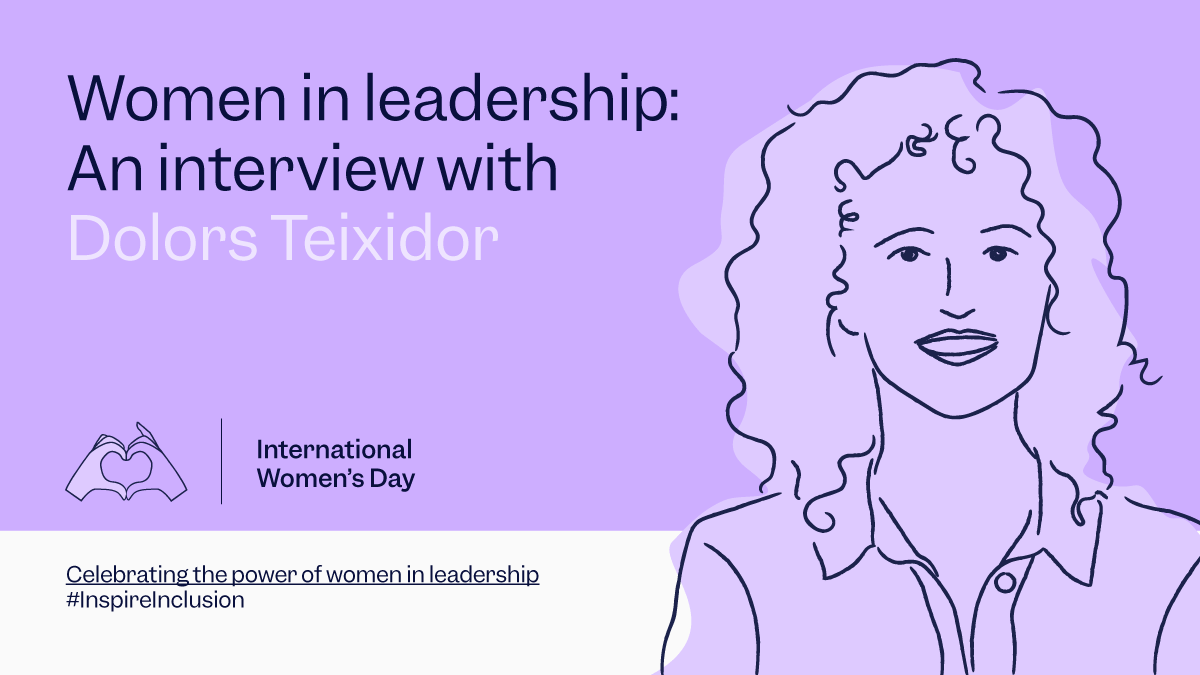
We sat down with our Chief Growth Officer to discuss how we can inspire inclusion in the workplace.
Dolors Teixidor, Chief Growth Officer, embarked on her journey with the company from its inception when it was a small team of just 4 or 5 members. Initially taking on a marketing role, her task was to navigate the challenges of introducing Scilife to the market, promoting its vision, and establishing brand recognition.
Playing a pivotal role in growing the marketing team, she now oversees not just marketing and data analysis but also cost management and brand strategy as Chief Growth Officer.
As a woman in leadership, we sought her insights on addressing the gender imbalance in senior roles, her experiences overcoming industry barriers, and strategies for creating a more inclusive and diverse workplace.
According to McKinsey, due to gender disparity in early promotions, men end up holding 60% of manager-level positions in a typical company, while women occupy 40%. What factors do you think have caused a gender imbalance in the workplace, specifically amongst senior leadership roles?
Well, first of all, at Scilife, this number is reversed as 60% of our leadership team is female. Additionally, within our European team, the workforce includes more women than men. When we were growing the company, I always made sure that we were interviewing just as many men as women. I believe the growth in the number of women on our team is significantly influenced by my leadership role and the fact that I am a woman.
Historically, leadership positions have predominantly been occupied by men, leading to a tendency where people in leadership roles often unconsciously select individuals who resemble themselves, usually other men, for their teams. This pattern, known as bias, means that without deliberate effort to include diverse perspectives, teams can end up being homogenous.
In my case, being a woman in a leadership position, I've contributed to changing this dynamic and increasing female representation on our team. It's a well-acknowledged fact that men have been more prevalent in leadership roles, which often leads to more men being chosen for subsequent leadership positions. By being in a leadership position myself, I've played a part in addressing and altering this trend.
I believe that several factors contribute to gender imbalance in the workplace, including women's self-doubt and societal biases that dictate gender-specific roles. However, women in leadership positions are pivotal in changing these dynamics, leading to more gender-diverse teams. In essence, the presence of women in leadership roles encourages a more inclusive environment, contributing to a balanced representation of genders within teams.
Have you faced any barriers in your career due to being a woman? If so, how did you overcome them?
Normally, you're not aware that you're being treated differently. And you don't perceive it as an injustice, or at least I didn't in my case, because it wasn't so blatantly unjust. But there are certain things, especially in the world of design and construction where I had worked previously. Because, after all, interior design is closely related to construction, and there are a lot of men involved.
In this industry, not every professional is a man, but often, a woman's opinion doesn't carry the same weight as a man's. I've been in this position multiple times, but you tend to get used to it and just keep moving forward. Once you successfully complete a project and it's clear that it has worked out well, you begin to earn their trust and respect. However, the path to gaining this recognition is usually more complex and lengthier for women than for men. Especially in tech and software companies, the industry is heavily male-dominated, with most clients and consultants being men, highlighting the gender imbalance we face.
When discussing technical matters with a team of men, if you're not technically inclined, it might lead to confrontations or make you feel hesitant to share your opinion. Over time, I've gained confidence. Seeing my contributions positively impact our work has gradually built trust with my colleagues, though navigating this environment often seems more challenging for women compared to men, in my experience.
It's important to acknowledge that men face their own set of challenges too, especially younger ones who can be questioned by their seniors. Advancing in any field or life in general presents hurdles, but it appears these challenges are amplified for women, making our journey to recognition and respect a bit more arduous.
How can leaders and organizations more effectively challenge and change these barriers to ensure inclusion?
I believe it all starts with the HR processes. Perhaps the questionnaires or the aptitude and personality tests are sometimes biased, favoring male roles and profiles over female ones. Maybe because traits like authority or negotiation skills are valued more, and women might not exhibit these as prominently. Perhaps there should be an inclusion of other competencies that are more traditionally feminine, so women can advance more in selection processes.
Additionally, an awareness that we might have these biased views means we can counter them – and working with a more diverse leadership team will lead to an equally diverse workforce which brings an increased variety of skills and ideas – and that can only be a good thing.
How important have allies been in your career, and what actions can everyone take to be a more effective ally for women?
Throughout my professional journey, I've been fortunate to have numerous allies. A notable example is Filip, the CEO of Scilife, who played a crucial role in building my confidence when I initially joined the company. As a woman, expressing my opinions or delving into technical discussions was daunting due to my lack of confidence.
Fillp's understanding, support, and trust have been instrumental in making me feel secure. He has been a steadfast ally throughout this journey, championing our ideas, especially when it meant diverging from conventional practices in our industry. Filip's belief in the potential of myself and the entire team of women was constant, entrusting us fully and encouraging us to proceed with our vision. This approach has proven successful, underscoring the value of trust and support in achieving our goals.
Finally, for women in leadership who strive to become better allies for women, it is important to consider their own experiences and avoid repeating the same challenges on the next generation. Instead, they should focus on smoothing the path forward. This approach should be adopted by leaders across the board, irrespective of gender.
In your opinion, what’s a good indicator to measure gender equality in the workplace?
A meaningful indicator of gender equality in the workplace is the representation of women across all levels of the organization, particularly on company boards and in leadership roles, especially within sectors like technology and software where imbalances are pronounced.
Examining not only the proportion of women in high-ranking positions but also their presence throughout the entire workforce is crucial. True gender equality is achieved when there's inclusive representation from the top decision-makers to specialists and the broader workforce.
It's perplexing to observe companies that operate under the misconception that a male-dominated team is superior. The notion of equity being normal, as supported by leaders like Filip who see no reason to question this equality, underscores the importance of embracing diversity at every organizational level.
Reflecting on your career, what stands out as your biggest achievement or the accomplishment you're most proud of?
Reflecting on my career, I enjoy being challenged and ultimately, It's not about a single, specific achievement but rather a series of challenges I've embraced and overcome to grow both personally and professionally.
And indeed, Scilife is a project that has turned out to be remarkably successful. It has allowed me to have a great time and the success of Scilife is not just a personal triumph but a testament to the collaborative effort of our exceptional team and the comprehensive strategies we've implemented. This project, which we ambitiously undertook, showcases the extent of my development and is the accomplishment that I am most proud of.
With the support of partners and the dedication of our team, this endeavor was not just my own but a collective challenge. Thinking beyond my individual perspective to a team-oriented viewpoint, we've collectively surmounted numerous obstacles and consistently achieved our set goals year after year.
What would your advice be to women who are trying to achieve their career ambitions?
Being a woman often means being a mother, a professional, and many other things and having diverse responsibilities. All of this is okay, and it's fun, exciting, and thrilling to experience it all—being a mother, having a family, having a good job, and having friends. It's entirely appropriate to chase career ambitions while juggling these diverse roles but finding the right balance is crucial. And truly, you can achieve a lot without having to give up other things.
If companies offered more flexibility, recognizing the occasional need for women to take career breaks, whether for a few months or even years, that would be a game-changer. If all this were naturally accepted and not seen as a burden or something negative for your career, not something that would demote you or deny you the same role when you return, perhaps women would feel more comfortable truly pursuing their ambitions. My advice is to seek out workplaces or create your own ventures, where this kind of flexibility and understanding is part of the culture. Working in environments that genuinely support this balance enables women to not feel torn between professional aspirations and personal commitments.
Why is it important for all companies to strive to have good gender diversity both within their workforce and among their leadership?
Because both men and women possess unique qualities as individuals, the greater the diversity – not only in gender but also culturally and across all dimensions – the richer and more valuable the outcome of what you're creating.
Diverse experiences contribute a level of value that a uniform perspective, where everyone has the same viewpoint, simply cannot match. This homogeneity diminishes creativity and the capacity for innovative, out-of-the-box thinking. I believe that embracing diversity in all its forms indeed enhances value, without a doubt.
What does International Women’s Day mean to you?
Certainly, International Women's Day carries a dual significance. On one hand, it highlights the ongoing need for such a day to amplify women's voices, underscoring a persistent gap in equality. This can be seen as a drawback. On the other hand, it serves as a positive occasion, a day dedicated to acknowledging women's existence and celebrating the continuous efforts and struggles toward achieving gender equality.





